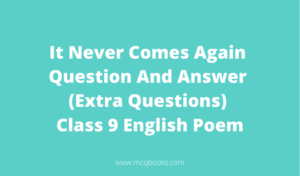It Never Comes Again Question And Answer (Extra Questions) Karnataka Board Class 9 English Poem
English is a difficult subject for many people to learn. Some students may become frustrated and give up, but here’s It Never Comes Again Question And Answer (Extra Questions) Karnataka Board Class 9 English Poem to help you maintain your momentum! This It Never Comes Again Question And Answer (Extra Questions) will provide all necessary information needed in order to study KSEEB Class 9 English successfully at home or school; it includes detailed grammar rules with examples that were used during today’s class discussion on the Karnataka Board English Exam.
The It Never Comes Again Question And Answer (Extra Questions) in English Chapter 8, Karnataka Board Class 9 makes it easier to understand the story. Understanding every detail of a story is important for scoring higher on an exam and expert writers have made sure that you know how everything flows together by summarizing perfectly!

Additional questions:
The best period of human life is:
A) Childhood
B) Middle age
C) Youth
D) Old age
Choose the correct option.
Ans: C) Youth.
We have the balms for
A) All our difficulties
B) All our pains
C) Works
D) All our happiness
Choose the correct option.
Ans: B) All our pains.
Figures of speech used in the poem:
Alliteration: This is a figure of speech where closely associated words or corresponding words begin with the same alphabet in a sentence.
“Still we feel that something sweet”
Personification: Personification is a figure of speech in which animals, or other inanimate objects are credited with human feelings, emotions and abilities.
“It takes something from our hearts,
And it never comes again.”
Here ‘it’ refers to youth. The poet attributed feelings of a living thing to ‘youth’. ‘It’ is personified here.
Metaphor: In this figure of speech, a comparison is made without the usage of any comparing words.
“But when youth, the dream, departs…”
Here a comparison has been made between ‘youth’ and ‘dream’.
Important word meanings:
Balms: Something that helps one relax.
Sterner: Stronger.
Sigh: Long deep breathe showing disappointment.
Behold: Look at.
Theme of the poem:
Youth is the most beautiful phase of one’s life. A person feels stronger and better then. He is filled with dreams and the urge to achieve them. It is itself like a dream. We gain a lot from it and lose when it leaves. Thus, we should always use it productively. The poem also gives a message that we should use our time in a productive way.
About the poet:
Richard Henry Stoddard, an American critic and poet was born in 1825 on 2nd July. He was born in Hingham, Massachusetts. He became a blacksmith and then an iron moulder. Also he used to read lots of poetry then. He was very much interested in literature.
In 1849, he gave up his job and started concentrating on literature. He began writing then. He had written for the “Union Magazine”, the “Knickerbocker Magazine”, “Putnam’s Monthly Magazine” and also the “New York Evening Post”. In 1852, he got married to novelist Elizabeth Drew Barstow.
Some of his most notable works as an editor are: “The Loves and Heroines of the Poets” (1861), “The Late English Poets” (1865) and “Female Poets of America” (1874) amongst many. His notable creations are: “Poems” (1852), “Town and Country” (1857), “The Book of the East” (1867), “The Lion’s Club, with Other Verse” (1890)
He passed away in 1903 on May 12.